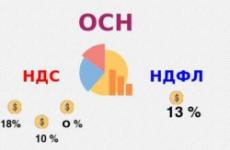Adjustment of taxable income. Adjustment of income tax
POPULAR NEWS
 Invoice: the line "government contract identifier" can be left blank
Invoice: the line "government contract identifier" can be left blank
From 01.07.2017, a new line 8 “Identifier of the state contract, agreement (agreement)” appeared in the invoices. Naturally, you need to fill in this prop only if it is available. Otherwise, this line can simply be left blank.
 Income tax: how to confirm the cost of an electronic ticket
Income tax: how to confirm the cost of an electronic ticket
If a ticket for a traveler was acquired in electronic form, a “boarding pass” with a note of inspection is required, among other things, to confirm “travel” expenses for “profitable” purposes. And what to do, if at a foreign airport such marks are not accepted?
 Determining the amount of “child” deductions will no longer cause difficulties.
Determining the amount of “child” deductions will no longer cause difficulties.
Most often, employees turn to the employer for a personal income tax deduction for children. And well, if the employee has only one child. And if, for example, four of them and two of them are already adults, then the accountant may have a question about the size of the “child’s” deduction. Our new will come to the rescue in a similar situation.
 Getting property tax breaks simplified
Getting property tax breaks simplified
Starting next year, citizens who are entitled to property tax, transport and / or land tax benefits will not have to submit documents confirming the right to a benefit to the Federal Tax Service.
 Simplify the use of PBU 18/02
Simplify the use of PBU 18/02
PBU 18/02, perhaps one of the most difficult. For each transaction, the accountant calculates temporary or permanent differences. Then - IT, IT, PNO or PNA. However, there is an alternative approach where you can do without complex calculations.
Contents of the journal No. 18 for 2014Yu.V. Kapanina, expert on accounting and taxation
Increased revenue for VAT and income tax: correcting a technical error
During the reconciliation with the customer, you found that as a result of a technical error, the documents (act and invoice) for services rendered last year (for example, in July 2013) services were invoiced for more than it should have been. It turns out that you calculated the income tax and VAT for that period incorrectly and paid “a little more” to the budget.
Immediately, we note that the errors that led to tax overpayment can not be corrected at all. clause 1, Article. 81 of the Tax Code. But you do not want to lose money, so we will consider ways to adjust.
Correction of documents
To start, make a service note on the identification of errors. It will be a document in which you record the nature of the error (for example, that it is technical) and its amount, confirm the date of its detection.
To make corrections to the primary organization (in our case, this is an act of providing services) is allowed. This is stated in the Accounting Law e part 7 of Art. 9 of the Law of 06.12.2011 № 402-ФЗ. But unilaterally, that is, without agreement with the counterparty, the act cannot be corrected, because it is a bilateral document and corrections must be certified by all persons who signed it.
Consider the example of how to make corrections to this primary document.
THE ACT OF PROVIDING SERVICES
moscow
LLC “Mechta”, hereinafter referred to as “Customer”, represented by General Director Lyudmila Prokofyevna Kukushkina, on the one hand, and Technoline LLC, hereinafter referred to as “Contractor”, represented by General Director Romanov Anatoly Sergeyevich, on the other hand, constituted this Act under the Paid Services Agreement No. 12 of July 2, 2013 as follows.
1. The Contractor has provided the Customer with the following services:
| № | Name of service | Unit rev. | Qty (volume) | Price (tariff) per unit of measurement, rub. | Cost of services, RUB, including VAT (18%) | Corrected on August 24, 2014 Write "Fixed" and be sure to specify the date of correction Kukushkina L.P. Romanov A.S. The correction must be certified by the signatures of those persons who signed the document earlier, with their names and initials. |
| 1 | Setting up the software for the local computer network | hour | 3 | 24 000 | 75 000
72 000 |
Total services rendered totaling 72,000 (seventy two thousand) 75,000 (seventy five thousand) rub. 00 cop Cross out the wrong amount with one line so that you can read the corrected, and write the correct data over the crossed out
2. Services are provided in accordance with the terms of the Agreement in full and on time. The customer has no claims on the volume, quality and timing of the services.
3. This Act is made in two copies, one for the Contractor and the Customer.
| On behalf of the Customer | On behalf of the Contractor | |
|
L.P. Kukushkina |
A.S. Romanov |
|
The order of correction of an invoice, in which a technical error was discovered due to incorrect input of the price or quantity of goods shipped (works performed, services rendered), differs from the procedure for correcting the primary document: you just need to create a new document clause 7 of the Rules for filling out an invoice, approved. Government Resolution dated December 26, 2011 No. 1137. But in the "simple" fix there are small nuances.
This is how the corrected invoice header will look like:
ACCOUNT-FAKTURA № 315 of July 31, 2013 Specify the number and date of the primary invoice
FIX No. 1 dated August 24, 2014 Specify the order number of the correction and the date of correction
Attention
There is no correction invoice in case of a technical or arithmetic error. Letters of the Ministry of Finance dated August 23, 2012 No. 03-07-09 / 125; The Federal Tax Service of 01.02.2013 № ED-4-3 / [email protected] .
Next, fill all the other lines with the correct values. Thus, in our example, only the cost of services (72,000 rubles) and the amount of VAT (10,983.05 rubles) will be corrected. A new copy of the invoice is signed by the manager and the chief accountant of the company (other authorized persons).
Give the second copies of the corrected documents to your counterparty.
We find out in what period to correct the identified error.
Income tax
If past errors are due to overstatement tax basethen you can fix them in two ways.
METHOD 1. Correction of errors in the current period. You have the right to take into account the amounts relating to previous periods in the current period, if the errors committed led to an overpayment of tax a par 3 p. 1 Art. 54 NK RF. That is, for our example in August 2014 in non-operating expenses it is necessary to include revenue, which is unnecessarily recognized in 2013, in the amount of 2,542.37 rubles. (3000 rubles x 100/118).
On the one hand, in the detection period it is possible to correct any errors in the calculation of the base, which led to the overpayment of the tax, regardless of the period of their commission. Ministry of Finance of Russia agrees with this and Letter of the Ministry of Finance of January 30, 2012 No. 03-03-06 / 1/40.
But on the other hand, correcting errors in the current period, do not forget about the three-year “period of their limitation”, which the Ministry of Finance regularly mentions in its explanations x Letters of the Ministry of Finance dated 08/04/2010 No. 03-02-07 / 1-153, dated 10/05/2010 No. 03-03-06 / 1/627. If 3 years have passed since the excessive tax payment for the year in which the error was made, it is more likely to be “returned” tax overpayment inspection will refuse.
And the courts can support the position of the inspectorate in this matter. If the identified errors relate to a period outside the period of the tax auditthen the taxpayer has no right to take them into account in the current period (when they were identified). After all, the tax is not able to verify whether this error led to a tax overpayment. This conclusion came, for example, FAS MO Resolution of the Federal Arbitration Court of the MO of 04.02.2013 No. A40-8920 / 11-116-23.
METHOD 2. Submission of a revised declaration for the previous period. It is also possible to reduce the overpaid tax with the help of clarification and clause 1, Article. 81 of the Tax Code. It is possible to immediately attach explanations to the revised declaration, which justify changes in the indicators of the declaration and par 2 p. 3 Art. 88 NK RF.
CONCLUSION
In our case, the error led to tax overpayment, which means that it is more convenient to correct it with the current period, that is, using method 1.
You can reflect the extra amount that has ceased to be income in the nearest income tax declaration as a loss of previous years identified in the current period, indicating it in line 301 of Appendix No. 2 to sheet 2 of the declaration.
But sometimes you can correct mistakes on income tax only by way of 2, that is, by submitting a clarification. These are the following situations:
P. 3 of Art. 169 of the Tax Code of the Russian Federation, the order of which is established by Decree No. 1137. So, the “last year’s” mistakes in the sales book can be corrected only in one way: you need to fill out an additional sheet of the sales book. Entries in it are made for the quarter in which the erroneous invoice is registered. In the additional sheet of the sales book, you cancel the invalid invoice (you need to write down its indicators with a negative value), and then enter the corrected invoice (with a positive value of m) section 3 of the Rules for completing an additional sheet of the book of sales, approved. Government Resolution dated December 26, 2011 No. 1137.
And then you need to submit a revised declaration for the relevant period (in our example - for the third quarter of 2013), reducing the tax base in it.
Correcting an error on VAT related to previous periods in the current quarter without conflicts with the inspection will not work. But maybe you are lucky in court. There is a court decision Resolution of the Federal Arbitration Court of Higher Education No. 20.03.2012 № А58-6572 / 2010 in favor of the taxpayer.
Due to technical errors made by the seller in the preparation of primary documents and invoices, the buyer suffers. True, he has worse things to do. He cannot fail to correct the mistake, since in his case the mistake did not lead to overpayment of taxes, but quite the opposite. With the period of correction of errors, too, everything is unambiguous - the buyer needs to submit updated VAT and income tax returns for previous periods. If the errors in the documents are not corrected, the inspector may find them when checking, and then you will have to part with the costs and deductions on VAT, pay fines and penalties.
OO Rozanov, Deputy Chief Accountant for Taxation of the Polyus Research and Production Center OJSC
In early 2012, the Presidium of the Supreme Arbitration Court decided<1> which made life easier for organizations. He acknowledged that the calculation of taxes included in expenses in an excessive amount (including due to the non-use of benefits) cannot be qualified as an error when calculating the income tax. And allowed not to submit a refined "profitable" declaration with a decrease in land, transport tax and property tax for past periods. That is, it is possible to include excessively calculated taxes in non-operating income in the period of the specified adjustment.
However, what is meant by the adjustment period is a question, as it turned out, ambiguous. You can talk about two options:
- (or) the filing period of the amended declaration on the "expenditure" tax;
- (or) The period of recognition by the tax authorities of overpayment of the "expense" tax.
For example, land tax for 2011 was overcharged. At the end of 2012, the organization
I discovered this and filed a specification for the land tax. The tax inspectorate agreed with the overpayment and returned the land tax as early as 2013. For what period of time should the “profitable” declaration include the amount of overpaid land tax: for 2012 or 2013?
The adjustment period is the period for filing an amended declaration.
The disadvantage of this option is that you reflect the excessively calculated tax in income and pay income tax on it, although in fact you have not yet received income. After all, the overpayment is not confirmed.
But the advantages of this option are simplicity and security.
But what to do if, after filing a revised declaration on a “spending” tax, the inspectorate refuses you, for example, to apply the exemption or for other reasons makes it illegal to reduce the tax?
If you do not want to argue with the tax authorities, then simply include the unrecognized amount of tax in non-operating expenses as losses of previous years, identified in reporting period <2> .
The adjustment period is the recognition period for tax overpayment.
Excessively calculated tax can be qualified as income of previous years, revealed in the current reporting (tax) period.<3> . And the date of receipt of such income is the date of its identification. In our case, this receipt of documents confirming the presence of income.<4> . That is, the presence of overpayment can be recognized at the moment:
- (or)getting the solution tax authorityconfirming the legality of reducing the "expense" tax and the right to offset<5> ;
- (or)return (offset) overpaid "consumable" tax<6> . Moreover, in one dispute, the court agreed with this position, despite the fact that about 2 years elapsed between the filing of the amended declaration and the return of the tax;
- (or)the entry into force of the court decision, which the inspection was obliged to offset (refund) overpaid “expenditure” tax, and issue a writ of execution<7> .
What type of behavior to choose - decide for yourself. It is especially important to determine the adjustment period, if the submission of the specification for the “expenditure” tax and the moment when the overpayment is recognized by the tax authorities relate to different tax (reporting) periods. Of course, a safer variant of interpreting the “correction period” is the moment of filing a revised declaration.
<1> Resolution of the Presidium of the Supreme Arbitration Court of the Russian Federation dated January 17, 2012 No. 10077/11.
<2> Subparagraph 1 paragraph 2 of Art. 265 Tax Code.
<3> Paragraph 10 of Art. 250 of the Tax Code of the Russian Federation.
<4> Subparagraph 6, paragraph 4 of Art. 271 of the Tax Code of the Russian Federation.
<5> Resolution of the FAS MO dated December 25, 2006, December 26, 2006 N KA-A40 / 12024-06.
<6> Resolutions of the FAS MO of 07.03.2013 N A40-56201 / 12-20-311; 19 AAC dated 02/25/2013 N A64-4701 / 2012.
<7> Resolution of FAS SZO of 08.05.2007 N A26-5588 / 2006-216.
Calculation of additional payments to the budget, calculated on the basis of the amounts of surcharges on income tax and advance contributions of income tax, adjusted by the discount rate of the Central Bank of the Russian Federation for using a bank loan
Example.
Based on the estimated profit for 1 quarter in the amount of 1000 thousand. rub. the amount of actually made advance contributions of income tax at a rate of 20% was 200 thousand rubles.
1. In fact, the profit for the first quarter was 1,200 thousand rubles, from which the tax in the amount of 240 thousand rubles was charged, i.e. advance payments were underestimated by 40 thousand rubles. Therefore, the surcharge of income tax for 1 quarter at interest rate The Central Bank of the Russian Federation for the use of a loan of 12% per annum, and for a quarter 1/4, i.e. 3% is:
40 * 0.03 = 1.2 thousand rubles.
The total amount of surcharges will be:
40 +1.2 = 41.2 thousand rubles.
2. If the actual amount of profit for 1 quarter is 900 thousand rubles, then the amount of tax due from this profit will be:
900 * 0.20 = 180 thousand rubles.
or less by 20 thousand rubles. (200 - 180 = 20) compared with the advance
tax contributions.
The return from the budget are not subject to 20 thousand rubles, but more by 0.6 thousand rubles. 20 * 0.03 = 0.6 thousand rubles.
The total amount of refund from the budget will be:
20 + 0.6 = 20.6 thousand rubles.
However, it should be borne in mind that the return from the budget can not be more than the amounts of advance contributions paid to the budget in the reporting quarter by this company. Additional payments to the budget (refunds) calculated on the basis of the amounts of income tax surcharges and advance tax payments, adjusted for the discount rate of the Central Bank of the Russian Federation for the use of a bank loan, are related to financial results.
Dividend taxation procedure
Chapter 25 of the Tax Code of the Russian Federation provides for the one-time taxation of dividends. Dividends accrued to shareholders from the profit remaining at the disposal of the organization are taxed at the source of payment at the rate of 9%, which is the same for legal and for individuals. A shareholder organization that receives dividends less a tax amount at a rate of 9% charges dividends to its shareholders.
The distributed profit includes the amount of dividends received, which is not taxable again at the rate of 9%.
Example.
The company distributes in the form of dividends profit in the amount of 500 thousand rubles, of which 100 thousand rubles. received as dividends from another joint stock company. The organization has three shareholders.
The amount of dividends that are taxed at the rate of 9% is 400 thousand rubles. (500 - 100), and the amount of tax - 36 thousand rubles.
The tax amount received is distributed in proportion to the share of each taxpayer. The distribution of the amount of dividends and the amount of tax is presented in the table.
Table 1 - Distribution of dividends and taxes
Practical lesson number 7
Independent solution of problems on income tax.
Example.
Initial data:
1. Accounting policies enterprises provided for the definition of revenue on payment.
2. In the reporting period, products paid by consumers in the amount of - 27 thousand rubles.
3. The total cost of the paid products - 18 thousand rubles.
4. Shipped products worth 21 thousand rubles.
5. The total cost of products shipped 16 thousand rubles.
6. Sold fixed assets - 8.2 thousand rubles.
7. The residual value of the fixed assets sold is 5 thousand rubles.
8. The service life of sold fixed assets 2.5 years
10. Penalties received under previously concluded contracts - 2 thousand rubles.
11. Accrued on the current account interest for the use of the bank free cash assets of the enterprise - 1 thousand rubles.
12. Taxes attributable to financial results were paid - 2 thousand rubles.
Decision:
one. . - VAT in the proceeds from the sale of products of primary production.
2. 27000 - 4117.5 = 22883 rubles. - revenue from sales of products of primary production excluding VAT.
3. 22883 - 18000 = 4883 rubles. - profit from sales of the main production.
4. ![]() .– VAT in the paid value of fixed assets.
.– VAT in the paid value of fixed assets.
5. 8200 - 1251 = 6949 rubles. - revenue from the sale of fixed assets excluding VAT.
6. ![]() . - profit from the sale of fixed assets.
. - profit from the sale of fixed assets.
7. 2000 + 1000 - 2000 = 1000 rubles. - surplus on non-operating transactions.
8. 4883 + 1289 + 1000 = 7172 rubles. - gross profit.
9. ![]() .– profit tax to the federal budget of the Russian Federation.
.– profit tax to the federal budget of the Russian Federation.
10. ![]() - income tax in the regional budget of the Russian Federation
- income tax in the regional budget of the Russian Federation






